UPSC Exam > UPSC Notes > Geography for UPSC CSE > Geography of Antarctica
Geography of Antarctica | Geography for UPSC CSE PDF Download
Antarctica
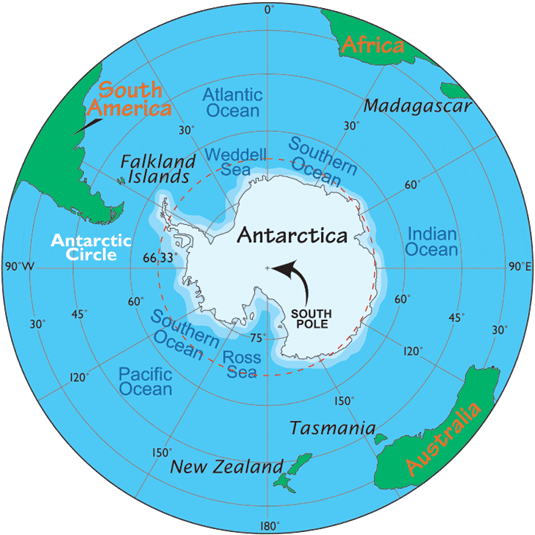
- It is the southernmost continent and lies entirely within the Antarctic Circle spread around the South Pole.
- To the south of India, beyond the Indian Ocean lies the frozen continent of Antarctica.
- The name means – opposite the Arctic.
- It separated from the rest of the world by the icy waters of the Southern Ocean which comprises the southern portions of the Indian, Atlantic, and Pacific Oceans.
- Its area is over 14 million square kilometers.
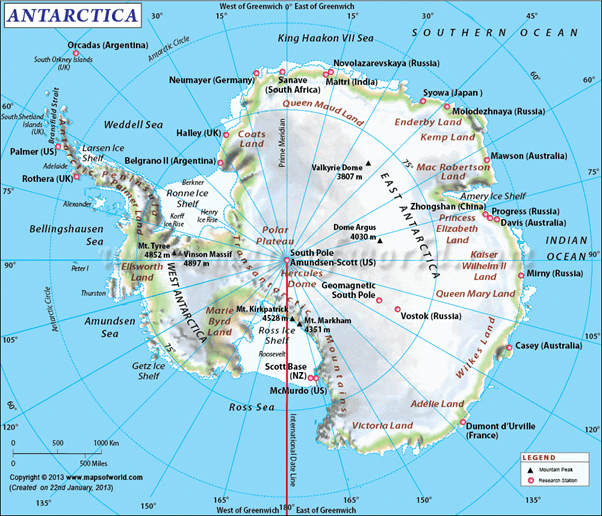
- It is the fifth-largest continent.
- It is larger than Europe and is twice the size of Australia.
- The continent is a high plateau that is frozen throughout the year.
- There is no coastal plain.
- There are mountain ranges, peaks, a rift valley, and volcanoes.
- Two broad inlets, the Weddell Sea and the Ross Sea and the Trans-
- Antarctic Mountains that cross the entire continent divide the land into West Antarctica and East Antarctica.
- The former faces the Pacific Ocean. The Antarctic Peninsula points towards South America. It is the continuation of the Andes Mountain range.
- East Antarctica, faces the Atlantic and Indian Oceans, Mount Erebus, an active volcano, is actually of the Ross Sea.
- It is the only continent that is completely covered by permanent ice and snow hence it is known as the white continent.
- In some places, its ice cap is 4,000 meters deep.
- The valleys between the mountain ranges are dry, windy, frozen, and barren, and strangely called oases.
Climate of Antarctica
- The climate of Antarctica is frozen cold because of its distance from the Equator and because of the great height of the plateau.
- In the winter months of May, June, and July the sun never rises and the temperature at the South Pole falls to minus 90°C.
- In the summer months of December, January, and February, the sun never sets and their continuous daylight. The summer temperature is about 0°C.
- Extremely cold and icy winds blow throughout the year.
- There is a marked difference between the summer and winter temperatures.
- There is also a vast difference between the temperatures of the continental interior.
- Most parts of the continent are dry with an average of 5 centimeters of rain annually.
- Antarctica is a cold desert.
- Mosses and lichens which cling to rocky slopes are found along the coast.
- There are scattered clumps of coarse grass and flowering plants in a few places where the climate is mild.
Aurora
- In winter, there is a continuous night for 3 months in the polar regions. Curtains of brilliant colored lights appear on these dark nights. They are caused by magnetic storms in the upper atmosphere.
- They are called Aurora Australis in the south and Aurora Borealis in the north.
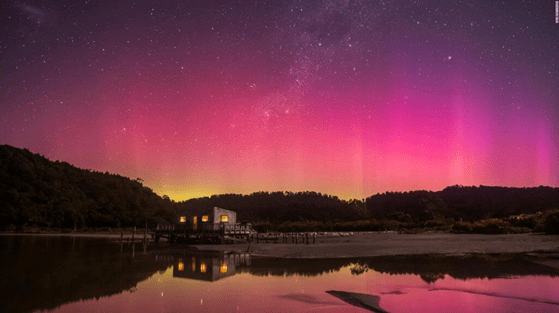
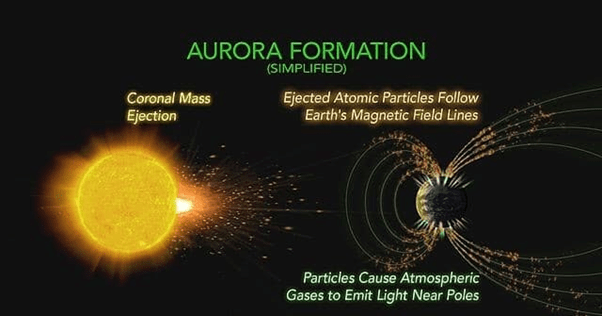

Minerals
- Scientific studies have shown Antarctica to be rich in gold, platinum, nickel, copper, and petroleum.
- But by the international Agreement, this continent is to be used only by scientists to study the climate of the Earth and the origin of its crust.
- About 70 percent of the Earth’s supply of fresh water can be extracted from the ice-caps of Antarctica.
Expeditions of Antarctica
- In 1912, a dramatic contest to reach the South Pole was held by two teams. The British team was led by Captain Robert F. Scott and the Norwegian team by Roald Amundsen.
- The five British men reached the pole only to find the Norwegian flag flying at the South Pole. They had been beaten by 34 days.
- Indian expedition to Antarctica had a 21 member team with Dr. S. Z.Quasim as its leader. It left Goa on the 6th of December 1981 and landed on the frozen continent on 9th January 1982.
- They set up a scientific station called Dakshin Gangotri laid plans for a second base called Maitri and named a point Mount Indira.
- They left automatic weather recorders powered by solar batteries at the stations.
- The South Pole is 2,250 kilometers away from Dakshin Gangotri.
The Antarctic Treaty
- The Antarctic Treaty was signed in Washington on 1 December 1959 by the twelve nations that had been active during the IGY (Argentina, Australia, Belgium, Chile, France, Japan, New Zealand, Norway, South Africa, United Kingdom, United States, and USSR).
- The Treaty, which applies to the area south of 60° South latitude, is surprisingly short, but remarkably effective.
- Through this agreement, the countries active in Antarctica consult on the uses of a whole continent, with a commitment that it should not become the scene or object of international discord.
- In its fourteen articles the Treaty stipulates that Antarctica should be used exclusively for peaceful purposes, military activities, such as the establishment of military bases or weapons testing, are specifically prohibited;
- Guarantees continued freedom to conduct scientific research, as enjoyed during the IGY;
- Promotes international scientific cooperation including the exchange of research plans and personnel, and requires that results of the research be made freely available;
- Sets aside the potential for sovereignty disputes between Treaty parties by providing that no activities will enhance or diminish previously asserted positions with respect to territorial claims provides that no new or enlarged claims can be made, and makes rules relating to jurisdiction;
- Prohibits nuclear explosions and the disposal of radioactive waste;
- Provides for inspection by observers, designated by any party, of ships, stations, and equipment in Antarctica to ensure the observance of, and compliance with, the Treaty;
- Requires parties to give advance notice of their expeditions; provides for the parties to meet periodically to discuss measures to further the objectives of the Treaty; and
- Puts in place a dispute settlement procedure and a mechanism by which the Treaty can be modified.

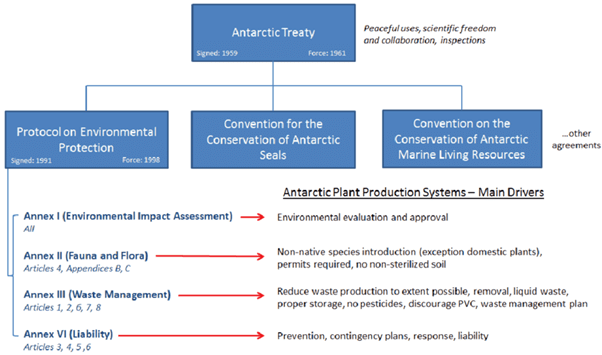
The document Geography of Antarctica | Geography for UPSC CSE is a part of the UPSC Course Geography for UPSC CSE.
All you need of UPSC at this link: UPSC
|
264 videos|875 docs|232 tests
|
FAQs on Geography of Antarctica - Geography for UPSC CSE
| 1. What is the geography of Antarctica? |  |
Antarctica is the southernmost continent on Earth and is located almost entirely within the Antarctic Circle. It is surrounded by the Southern Ocean and covers an area of about 14 million square kilometers. The geography of Antarctica is characterized by its vast ice sheets, mountain ranges, and frozen plateaus.
| 2. How is the climate in Antarctica? |  |
Antarctica has an extremely cold and harsh climate. It is known as the coldest place on Earth, with temperatures regularly dropping below -50 degrees Celsius (-58 degrees Fahrenheit). The continent experiences strong winds, low humidity, and very little precipitation, mostly in the form of snowfall.
| 3. What are the main geographical features of Antarctica? |  |
Antarctica is dominated by its ice sheets, with the East Antarctic Ice Sheet being the largest ice sheet in the world. The continent also has several mountain ranges, including the Transantarctic Mountains and the Ellsworth Mountains. Other notable geographical features include the McMurdo Dry Valleys, which are one of the driest places on Earth, and the Ross Ice Shelf, the largest ice shelf in Antarctica.
| 4. Are there any permanent residents in Antarctica? |  |
Antarctica does not have any permanent residents. It is governed by the Antarctic Treaty System, which prohibits any military activity, mineral mining, and nuclear testing on the continent. However, there are research stations operated by various countries, where scientists and support staff stay temporarily to conduct scientific research.
| 5. How does the geography of Antarctica affect its wildlife? |  |
The extreme geography of Antarctica, with its freezing temperatures, limited food sources, and vast ice-covered areas, has a significant impact on the wildlife that inhabits the continent. Only a few species, such as penguins, seals, and seabirds, have adapted to survive in this harsh environment. The nutrient-rich waters surrounding Antarctica support a diverse marine ecosystem, including krill, which is a primary food source for many Antarctic species.
Related Searches
















